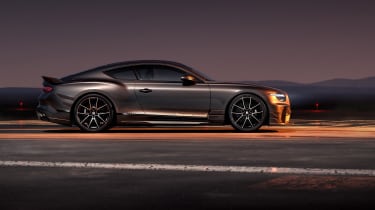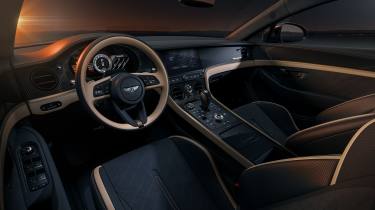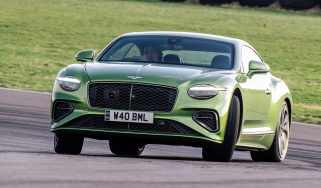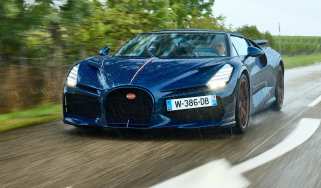The Bentley Continental GT Supersports is slower than before, but we don’t mind
Bentley has revived the Supersports name for 2026, but this time, it’s taken an entirely different approach to the hardcore GT
To celebrate 100 years since it launched its first 100mph-capable car, the Super Sports, Bentley has launched one of the most radical models in its history. The new Continental GT Supersports might follow the 2009 original and the later car from 2017, but this hardcore Bentley is unlike anything it’s done before. It’s more exclusive, too, strictly limited to 500 cars, with order books opening in March 2026.
While its two modern predecessors chased top speed, powered by the firm’s iconic W12 power plant, Bentley’s taking an entirely different approach here. For the first time in the history of the Continental GT (with the exception of the GT3 car), this is a fully rear-wheel drive car, a move designed to make it more engaging than anything before it.
> Who makes the best GT car? Aston Martin v Bentley v Maserati
Sending 657bhp and 590lb ft of torque to the rear axle is not the now-discontinued W12 of its Supersports ancestors, rather an uprated take on Volkswagen Group’s ubiquitous 4-litre twin-turbocharged V8. Unusually though, unlike the rest of the current range, it’s not supported by a plug-in hybrid system, the new Supersports ditching electrification entirely for a back-to-basics pure-combustion experience.
To achieve this output from a pure-combustion powertrain, the V8 features an uprated crankcase, new cylinder heads and larger turbochargers to give it the highest specific output of any of its engines – it breathes through a full titanium Akrapovic exhaust system too. Even its eight-speed dual-clutch transmission hasn’t remained untouched, with the clutches upgraded and software tuned for sharper shifts up and down.
Pair the removal of the hybrid system with the lack of drive to the front wheels and predictably, there are huge weight savings. While we don’t have an exact figure, Bentley says this is its lightest car in 85 years, dropping kerb weight by over 280kg over the previous Supersports to take it under 2000kg. The keen-eyed will have spotted that its 657bhp output is lower than the 700bhp of the previous car, but its weight advantage makes its power-to-weight ratio more favourable at over 329bhp/ton – the previous car made do with ‘just’ 307.
This improvement in power-to-weight makes Bentley's goal of focusing on engagement clear. Indeed its 3.7sec 0-62mph sprint will never match the 3.4sec time of its more powerful all-wheel drive predecessor (or even the current GT Speed for that matter), and its 192mph top speed makes it the only modern Supersports not to top 200mph – it’s a whole 17mph behind the 209mph of the 2017 car and some way from the 204mph of even the 2009 car. In the real world though, this shouldn’t matter.
With double wishbones at the front, a multi-link setup at the rear, new twin-chamber dampers and the firm’s trick 48V anti-roll system, this is set to be one of the most dynamically capable Bentleys we’ve seen. Track at the rear has even been widened by 16mm, its electronically controlled limited-slip differential assisted by torque vectoring by braking and its rear-wheel steering system remains in place. All of these systems have been recalibrated to suite this new package too, with revised ESC modes giving the driver full control: Dynamic offers a degree of slip, with everything off allowing for what Bentley is calling 'significant but highly controllable oversteer'.
Given its performance credentials there’s no surprise its design is more aggressive than the standard car, but Bentley’s taken it to the extreme. The front bumper is completely new and includes the largest front splitter ever fitted to a Bentley road car, with pronounced vertical intakes feeding air to the brakes and engine. Carbonfibre canards, an aggressive new side sill, rear diffuser and a huge fixed ducktail spoiler at the rear all contribute to 300kg more downforce than you get in the Speed.
The wheels are 22-inch forged items designed in collaboration with Manthey Racing, with the largest automotive braking system on the market nestled within them – 440mm and 410mm carbon ceramic discs can be found front and rear, with ten- and four-piston calipers acting upon them respectively. Pirelli P-Zero tyres are standard-fit but buyers can option sticky Trofeo RS rubber at a cost to allow for a 30 per cent improvement in cornering speed over a GT Speed.
In-keeping with the focused nature of this car, the cabin ditches rear seats entirely, with a carbonfibre and leather ‘tub’ now in their place. This isn’t just an aesthetic choice either, as it has allowed Bentley to remove not only the weight of the seats, but also sound insulation and the speakers designed for the rear passengers. In the front you get two new sports seats mounted in a lower position than before, but they do retain the heated function and are 11-way electronically adjustable.
The 2026 Bentley Continental GT Supersports will go on sale in March 2026 before production begins in Q4. Pricing is yet to be announced, but given the current GT Speed costs from £236,600, expect a price in excess of £250,000.
2026 Bentley Continental GT Supersports specs
| Engine | 4-litre twin-turbocharged V8 |
| Power | 657bhp |
| Torque | 590lb ft |
| Weight | <2000kg |
| Power-to-weight | >329bhp/ton |
| 0-62mph | 3.7sec |
| Top speed | 192mph |
| Price | TBC |










